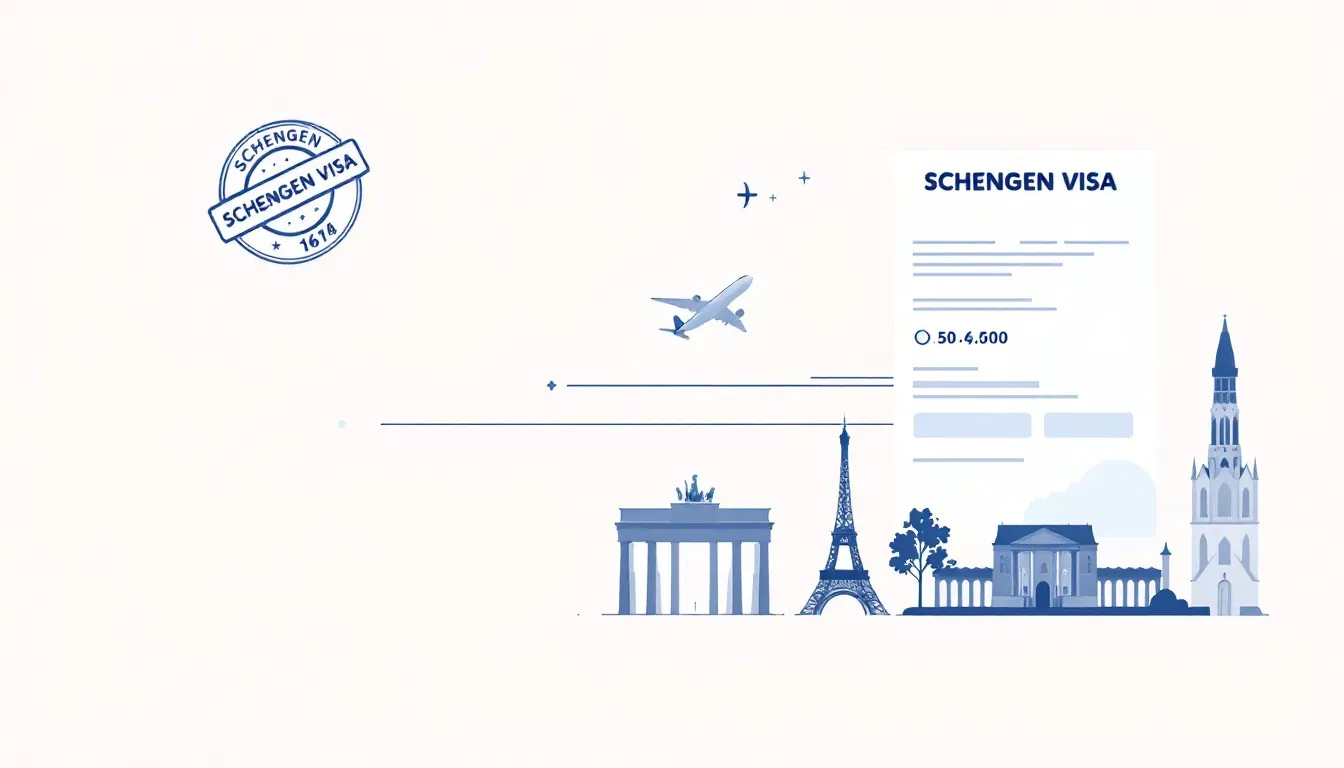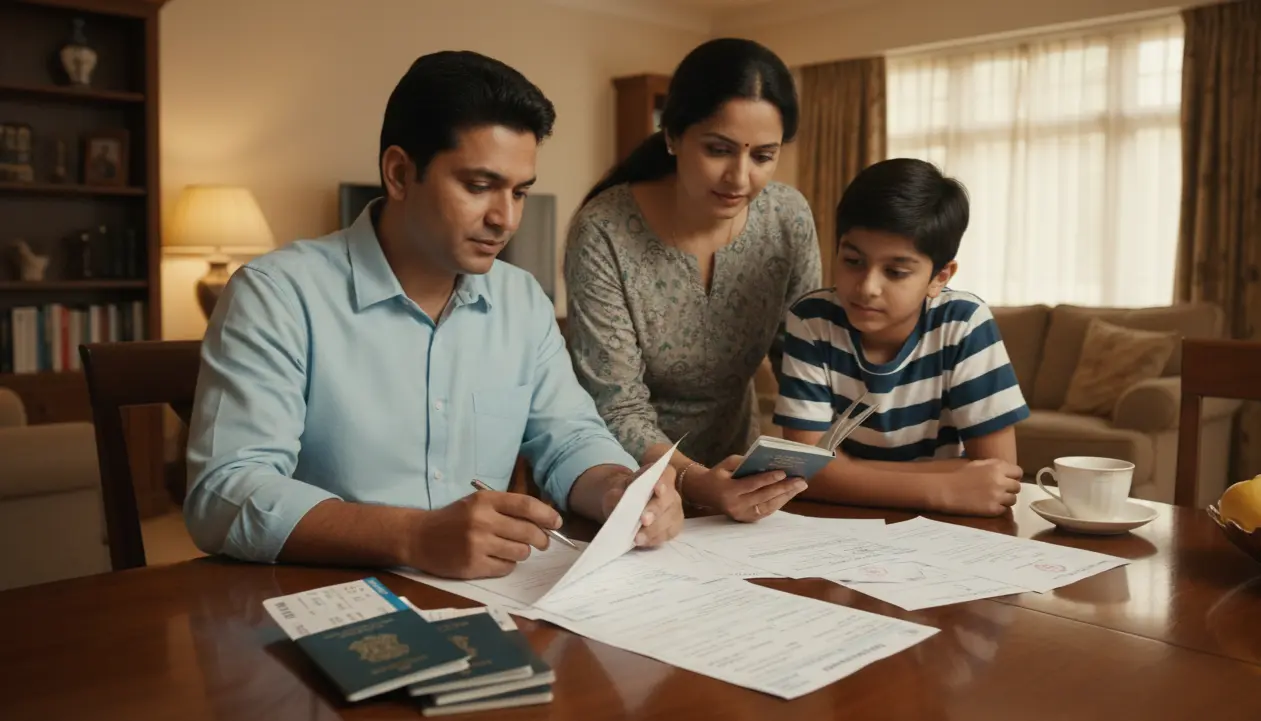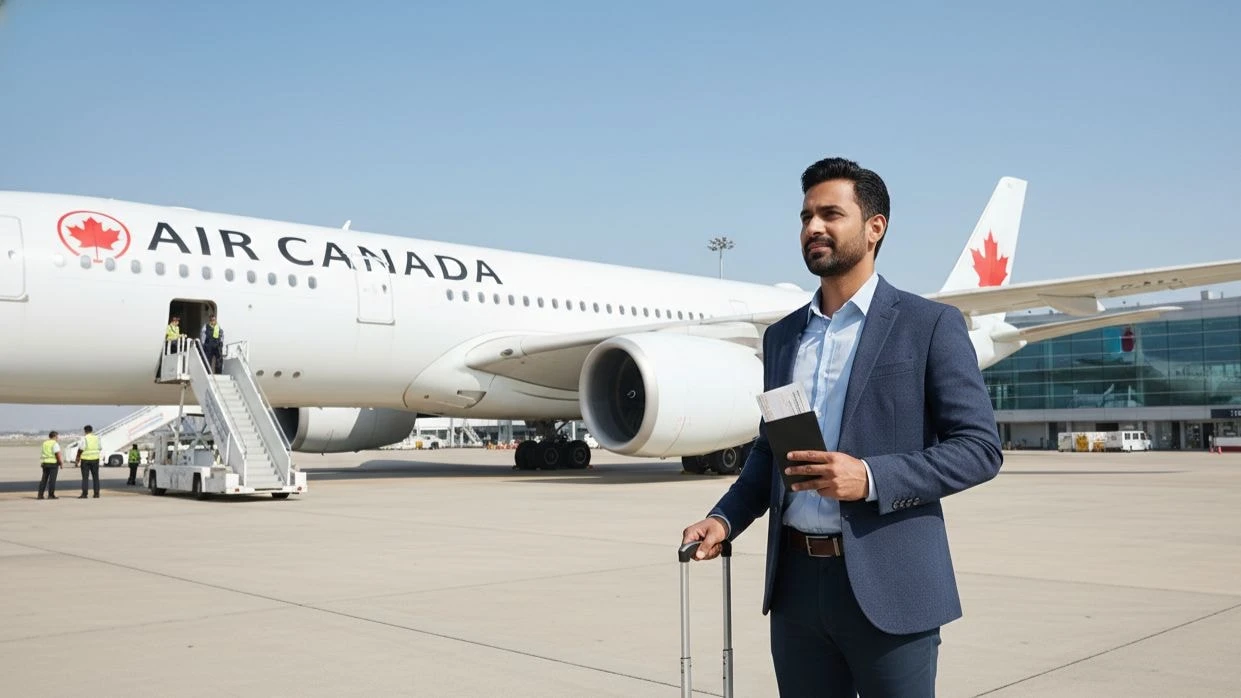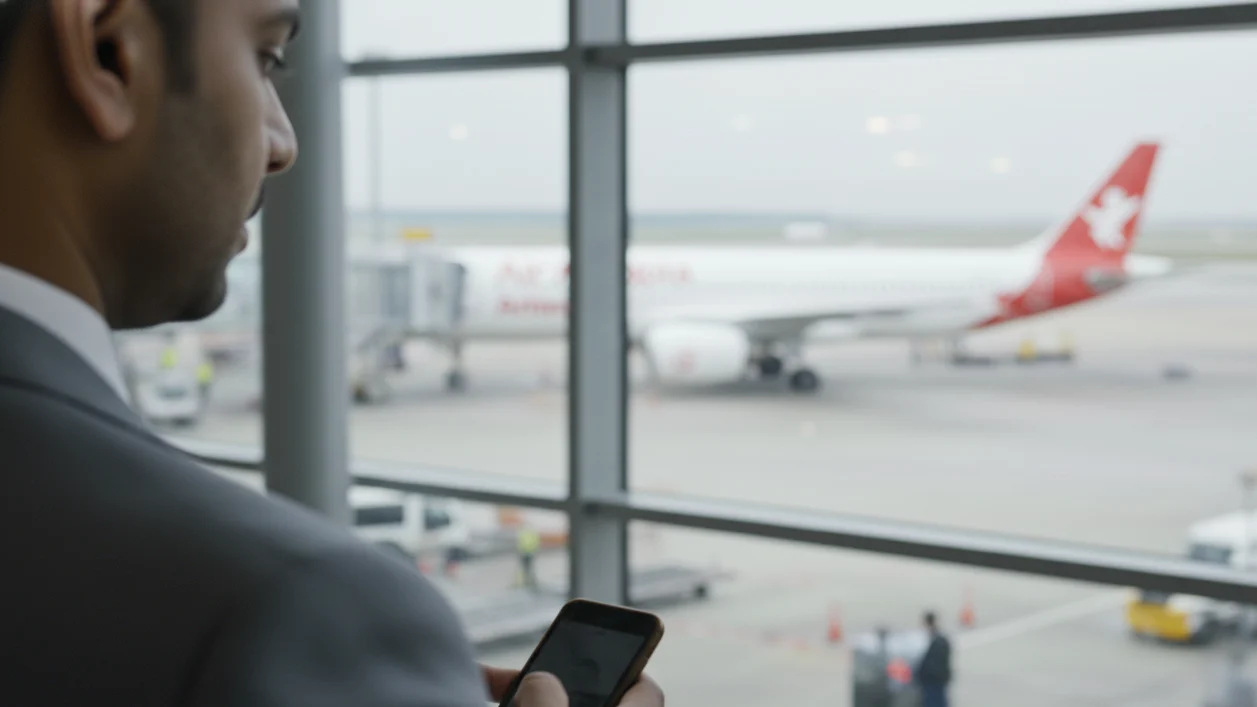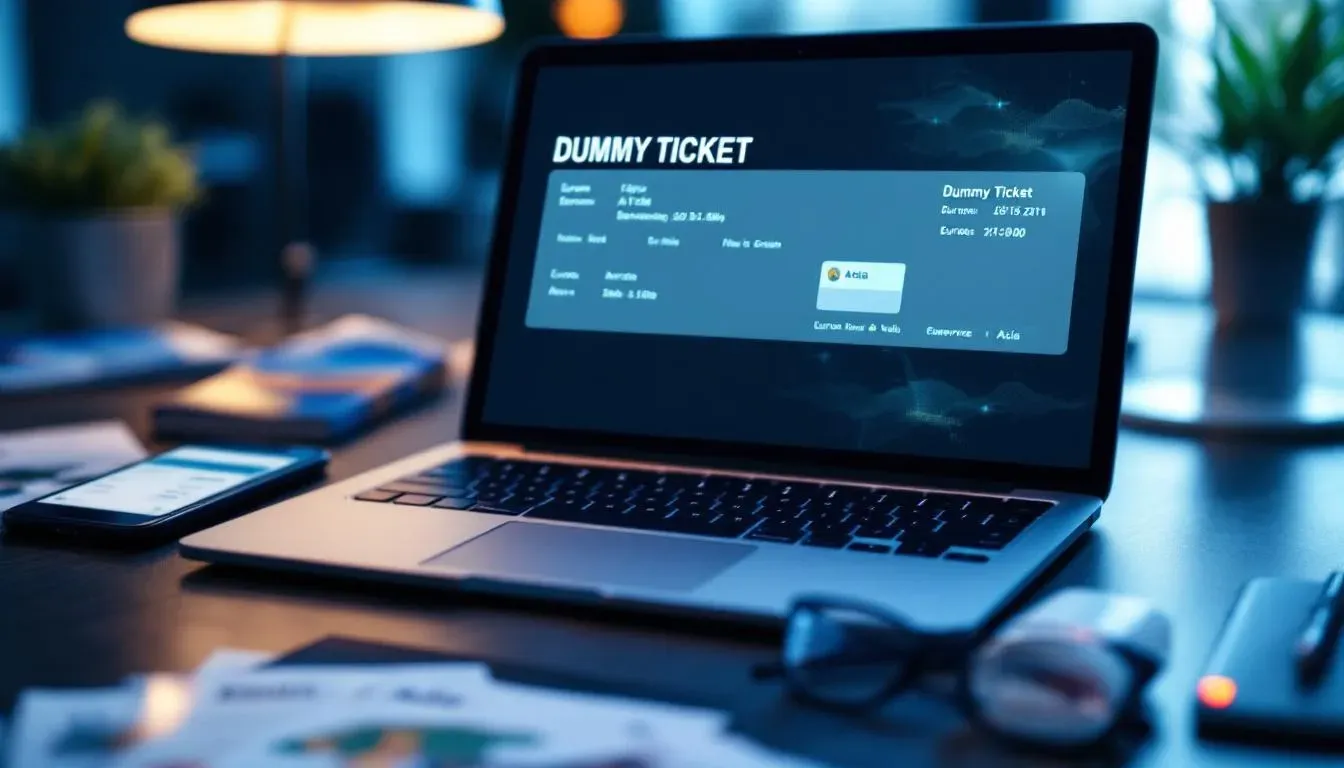Get a 14-Day Flight Reservation for Visa — Verifiable, Instant, Embassy-Approved
Visa prep in India rewards timing, not luck. You already know what a reservation is. What you need is a plan that keeps your itinerary live while slots, biometrics, and documents shuffle around. That is where a 14-day validity makes the difference. It buys you certainty through VFS queues, courier returns, and embassy callbacks. For more tips on preparing your documents, check our FAQ.
A two-day hold often expires mid-process. We will show you when a longer hold is smarter, how to get it in minutes, and how to keep the PNR verifiable the whole time. Get your 14-day verifiable reservation now—start with our dummy ticket booking. If you're new to this, explore our blogs for deeper insights into visa strategies.
A 14-day flight reservation for visa is an extended dummy ticket that remains valid and verifiable for up to two weeks — ideal for travelers with embassy appointments or visa processing delays. Unlike short-term 24- or 48-hour reservations, these long-validity flight bookings stay active in airline systems, allowing applicants to safely submit or update their visa files without rebooking. BookForVisa.com provides genuine flight reservations with real Passenger Name Records (PNRs) that remain verifiable online for 7–14 days, ensuring compliance with Schengen, UK, US, UAE, and Canada visa standards.
Last updated: October 2025 — verified for extended-validity flight reservations accepted by major embassies and VFS Global centers worldwide.
Table of Contents
Understanding the nuances of visa applications can be overwhelming, especially with fluctuating appointment dates. Learn more about our team's expertise on our About Us page to see how we support travelers like you.
Why A Flight Reservation For 14 Days Is Your Safety Net In India
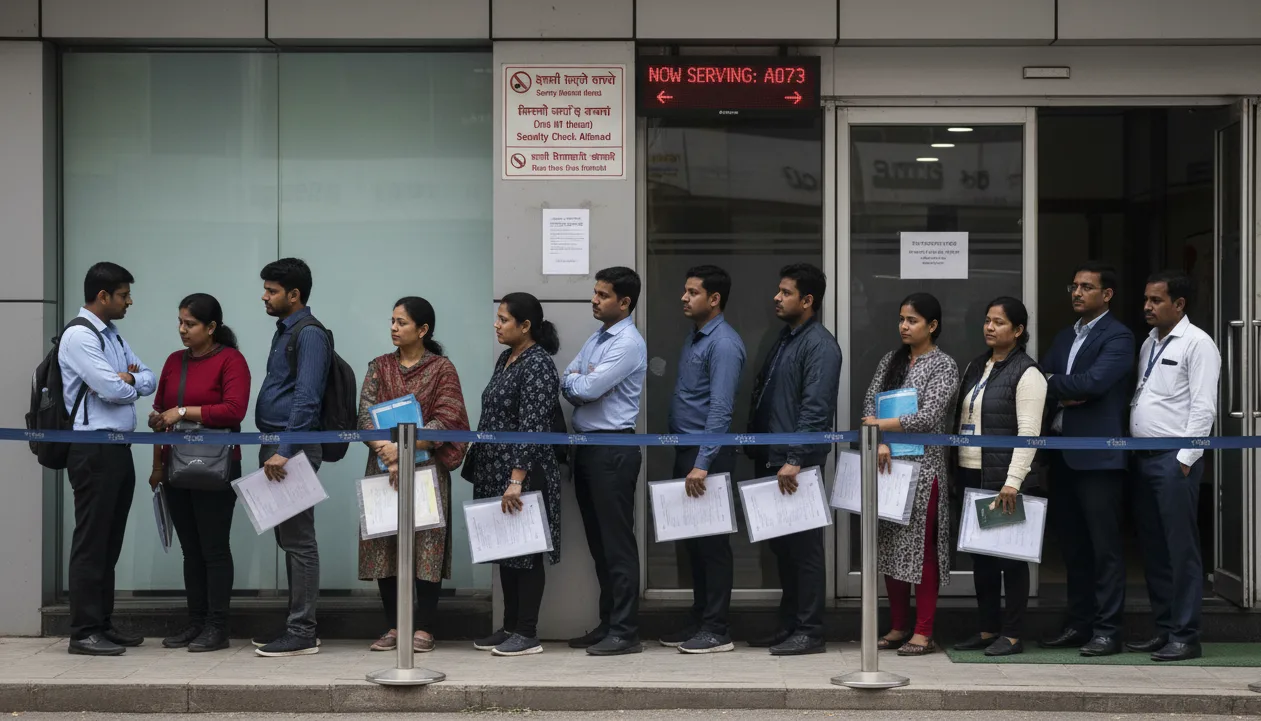
You want your visa file to move once and move cleanly. That is hard in India. Slots open and close. Biometrics get spaced out. Couriers take their time. A 14-day flight reservation gives you breathing room so your itinerary stays alive while the rest of your paperwork catches up. Ready to submit this week? Skip the hassle and book a dummy ticket in minutes.
The Ground Reality Across Indian Cities
Appointment hunting is not uniform. Delhi and Mumbai feel different from Bengaluru, Chennai, Hyderabad, Kolkata, and tier-2 centers. Summer breaks, university intake months, and festival peaks squeeze capacity. If you aim for June to August, or mid-December to early January, assume higher demand and slower callbacks. A two-day hold often expires before you even print your file. A 14-day hold keeps the PNR visible through the shuffle. To stay updated on seasonal trends, visit our blogs.
Why The Extra Days Change Your Workflow
A longer hold aligns with the real steps you face:
- You secure a VFS slot that sits five to seven days away.
- Your bank statement or employment letter needs a fresh date.
- The embassy asks for a revised day count on insurance.
- Your hotel voucher shifts by two nights.
- A courier delay pushes your pickup to next week.
With 14 days, you revise once, not three times. The PNR remains verifiable on the airline site while you align the rest. This approach minimizes errors and saves time, as many of our users have shared in our FAQ.
Students, Families, Business, And Digital Nomads
Different profiles, same pain point. Timing.
- Students
CAS or I-20 lands later than expected. Fee receipts clear midweek. Hostel letters move by a few days. You want a live itinerary that survives these swings. - First-Time Applicants
You are learning the rhythm. Bank statements, cover letters, and travel insurance rarely finish on the same day. A longer hold removes the panic of re-issuing reservations. - Family Visitors
Coordinating two to five passports is a puzzle. One person’s appointment slips and the entire plan shifts. Keeping a single PNR alive simplifies the stack. - Business Travelers
Invitations and meeting agendas are fluid. You often confirm dates after the slot is booked. A 14-day hold avoids back-and-forth PDFs. - Digital Nomads
Multi-city routes and flexible stays create moving parts. A PNR that stays live for two weeks lets you fine-tune transit rules, layovers, and onward segments.
What Indian Embassies And VFS Actually Expect
They want a reservation that matches your story. Dates must align across flights, hotels, and insurance. Names must mirror the passport. The booking should be checkable on the airline or a global booking system. A 14-day hold helps you maintain that consistency if any single document shifts a little. For official guidelines, refer to the IATA standards on travel documentation.
Where Two Days Come Up Short For A Dummy Ticket
Short holds look cheap until you need to change them twice. Common traps:
- The appointment is four days away. Your two-day PNR disappears the night before biometrics.
- The embassy requests a minor date change. The old PNR cannot be revived, so you start over.
- A public holiday stalls courier movement. Your reservation expires mid-route.
Each reset introduces new dates, new PDFs, and the risk of mismatched documents.
Budget Math That Actually Favors Longer Validity
Re-issuing short holds adds up. Even if a two-day file looks cheaper today, the total cost rises when you reprint twice. Longer validity reduces the number of times you pay, print, and explain. That also reduces mistakes. You spend less time editing your cover letter and a day-wise plan to mirror new dates. Over time, this can save you hundreds of rupees in avoidable fees and rushed bookings.
Seasonality And Regional Nuance Matter
Plan for crunch periods:
- University Intakes
July to September and January intakes strain student lanes. - Festivals And Public Holidays
Diwali, Christmas, and long weekends affect staffing and courier schedules. - Tourist High Season
Europe in summer and Middle East during school breaks push demand.
If your slot falls anywhere near these windows, the 14-day cushion is not a luxury. It is insurance against volatility. In high-demand cities like Delhi, this buffer can prevent weeks of delays.
Keep Your File Cohesive While The PNR Stays Live
Use the extra days to lock the whole stack:
- Align hotel check-in and check-out with flight arrival and departure.
- Adjust travel insurance start and end to match updated dates.
- Update your cover letter and day-by-day plan with the final timings.
- Save a timestamped screenshot of the airline's Manage Booking page.
When everything agrees, officers read your file faster. Cohesion signals credibility. To expand on file organization tips, see our detailed About Us section.
Avoid The Silent Killers Of A Good PNR
You can still break a strong reservation if you are careless.
- Frequent micro-changes trigger airline purges. Batch edits.
- Seat selection on an unticketed hold confuses some systems. Skip it.
- Sharing the PNR widely invites accidental changes. Limit who touches it.
- Mixing providers creates split control. Keep one owner for the hold.
Treat the PNR as the spine of your file. Protect it so the rest of your documents do not wobble. Common errors like these are covered in our FAQ.
The Simple Promise Of 14 Days
You want fewer surprises. A two-week validity gives your plan room to breathe without going stale. You keep the booking visible, match supporting proofs, and step into the appointment with a clean, consistent story. That is how applications glide through in India.
When you are ready to create the reservation, choose the validity that matches your timeline. In the next section, we will show you the exact steps to get a 14-day hold and set it up correctly from day one.
👉 Order your dummy ticket today for seamless visa support.
How To Lock A 14-Day Flight Hold In India Without The Headache
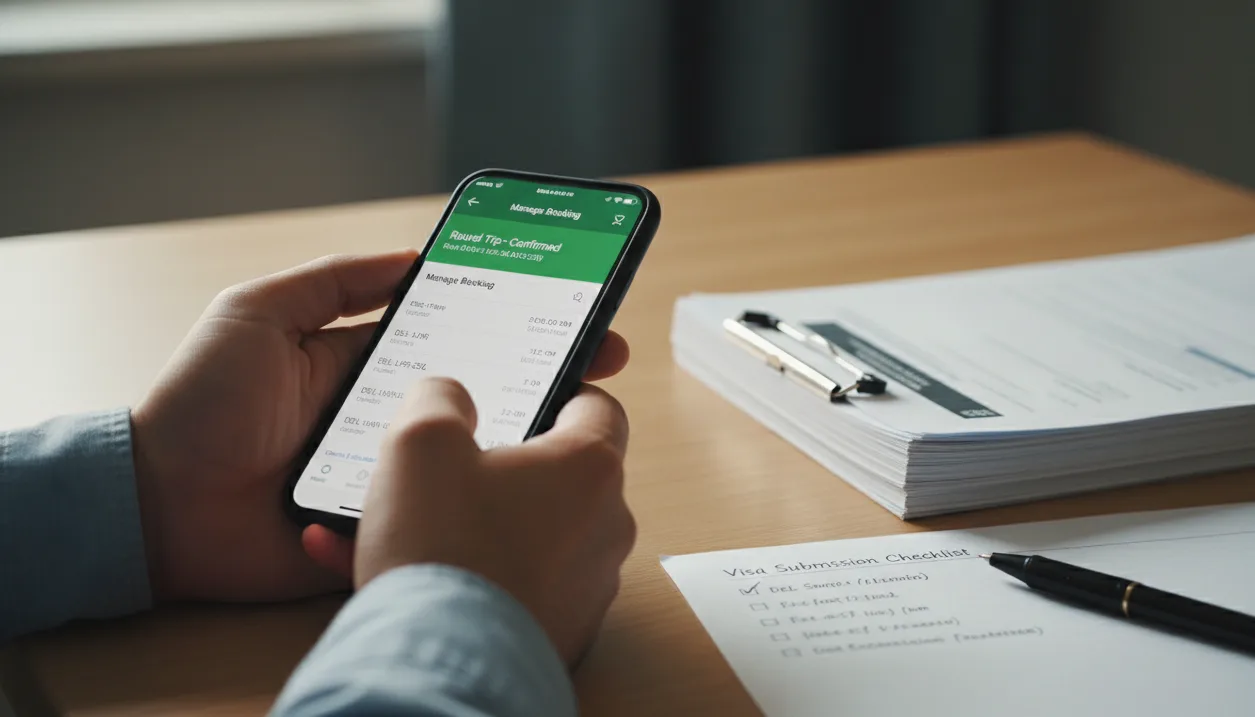
You want a reservation that stays alive while slots and documents settle. The trick is to plan backward from your submission date, pick the right hold type, and keep every supporting paper in sync. Here is the clean, India-ready way to set it up. Keep your file consistent and calm—use our fast dummy ticket booking.
Start From Your Actual Submission Date, Then Work Backward
Most problems begin with dates. Fix your VFS or embassy submission target first. Then count back.
- If your submission is five to ten days away, a 14-day hold fits the whole cycle.
- Add slack for courier time, city holidays, and possible document rechecks.
- If your city often shifts appointments by a few days, pad the plan by three to five days.
This backward plan keeps the hold alive through the messy middle, not only on the day you book it. Planning ahead like this is a key strategy shared in our blogs.
Pick The Right Reservation Type For Your Use Case
Two tools, two jobs.
- 14-Day GDS Reservation
Best for online submissions or when your appointment is not immediate. It gives you space to align hotels, insurance, and letters while the PNR stays visible. - 2-Day eTicket-Style Reservation
Best when you have an in-person appointment within 24 to 48 hours. Tight window, quick submission, minimal changes.
If the plan is in flux, begin with 14 days. Switch to a short window only when your slot is locked and closed. This flexibility ensures your dummy ticket serves its purpose without unnecessary stress.
Gather The Essentials Before You Create The Hold
Have your inputs ready to avoid edits that can shorten a hold.
- Names exactly as per passport, including middle names.
- Route with realistic layovers that match visa rules.
- Preferred travel window with a fallback option by plus or minus three days.
- Alignment targets for hotel check-in, check-out, and insurance coverage.
- Any transit restrictions for Schengen, UK, US, or Gulf connections.
Good inputs reduce re-issues. Your PNR lives longer when you do not keep poking it. Double-check these against common queries in our FAQ.
Build A Simple India-Specific Timeline That Actually Works
Use this repeatable rhythm.
- Pick a submission date that avoids local holidays and school rush.
- Create a 14-day reservation covering your preferred dates.
- Sync hotel vouchers and insurance to the same dates.
- Generate your cover letter and day-by-day plan with those dates.
- Recheck the PNR on the airline site on day two, day five, and two days before submission.
- Print fresh screenshots 24 hours before your appointment or upload online.
Small steps, big impact. Officers see a consistent story, not a moving target. This timeline has helped thousands, as detailed in our About Us story.
BookForVisa.com: A Reliable Option For Dummy Return or Onward Tickets
When you want a long-validity reservation that stays verifiable, you can use BookForVisa.com. We provide a 14-day GDS reservation designed for visa use with a live, checkable PNR on the airline site. Delivery is instant in PDF, so you can print or email it right away. Pricing is $15 (about ₹1,300), which makes it affordable for visa applicants in India.
You can change dates freely if your slot moves. Use this for online submissions or when your appointment is several days away and you need the itinerary to stay live while you align hotels, insurance, and supporting letters. Our service integrates seamlessly with tools like those from dummy ticket providers for extended support.
Keep Hotel Bookings And Insurance In Lockstep With The Flight Booking
Your reservation should anchor the rest of the file.
- Hotel vouchers must reflect the same nights you show on flights.
- Insurance should start on departure day and end on return, plus a buffer if the destination requires it.
- If the flight dates move, shift the hotel and insurance together, and regenerate your cover letter.
Embassies care about coherence. When everything matches, your file reads clean. Misalignments are a top reason for queries, so sync early.
Set A Change Strategy So Updates Do Not Break The PNR
Changes happen. Control them.
- Batch edits. Avoid daily tweaks.
- If you must move dates, do it once across flights, hotels, and insurance in the same hour.
- Keep one owner for the booking. Split control leads to silent cancellations.
- Save a log with the PNR, the last verified timestamp, and any edits made.
This keeps the record stable while still giving you flexibility. Logging changes also builds a strong audit trail for any embassy reviews.
Verify The Hold Like A Pro On Airline Websites
Do not rely on PDFs alone. Confirm it lives.
- Use the six-character PNR on the airline's Manage Booking page with the last name.
- Check passenger names, city pairs, and dates. Confirm segments show as holding confirmed.
- If you see strange codes, note them and retest in a few hours or on the operating carrier’s site.
- Save dated screenshots to your Visa Itinerary folder.
You are building an audit trail that the officer can trust. Regular checks like these prevent 90% of last-minute issues.
Troubleshoot Early So You Never Scramble Late
If the PNR does not display, act now.
- Re-enter the code carefully. People mix up O and 0.
- Try the operating carrier if the marketing carrier is slow to refresh.
- If a segment shows cancelled, ask for re-protection or a fresh PNR with the same timing.
- Keep one backup itinerary inside your 14-day window. You will rarely need it, but it ends panic.
Early checks beat last-minute firefighting. Proactive troubleshooting is emphasized in our comprehensive blogs.
India-Focused Examples To Guide Your Choice
- Student In Bengaluru
CAS lands midweek. Submission is five days away. Pick a 14-day hold. Sync hostel letter and insurance. Submit once. - Family In Mumbai
Two adults and one minor. One passport picks up late. The 14-day window covers the delay without re-issuing flights. - Business Traveler From Delhi
Meeting dates drift by three days. Keep the long hold while the invite finalizes. Switch to a short window only if you get a sudden early slot. - Digital Nomad In Goa
Multi-city Schengen with flexible exit. A longer hold lets you tune layovers and onward legs without killing the PNR.
The Payoff
You spend less, print fewer times, and walk into submission with a file that matches end to end. A 14-day reservation is not about buying time. It is about removing chaos. Plan backward, choose the right hold, keep every piece aligned, and verify like clockwork. That is how you move through India’s visa steps with calm and control. Many travelers report faster approvals with this method.
What Travelers Are Saying
How To Verify A 14-Day Hold And Keep Your PNR Alive In India
You secured the hold. Now you need proof that stays live until submission. The goal is simple. Keep the record visible on the airline, line up supporting papers, and walk in with a clean, verifiable story. Need a fresh PNR before your slot? Book a dummy ticket and print instantly.
Start With The Airline Check That Actually Matters
Open the airline’s official Manage Booking page. Enter the six-character pnr code and the last name exactly as it appears on the passport. You should see your flight itinerary, passenger names, city pairs, and the booking code or booking number on the screen. Save a timestamped screenshot.
Look for a confirmed booking with real segments, not a sample ticket. The page should show flight numbers, flight name where relevant, departure time, and arrival times. If the site asks for a flight reservation number or e-ticket number, use what your provider sent. A valid PNR on the carrier’s page is the best signal that your reservation for visa is in good shape. This step is crucial for compliance with international standards.
Decode What You See So You Do Not Panic
Statuses like HK generally mean the seats are holding. If you see changes to flight details, check your other documents before printing. A switch of timings can break hotel reservation dates or travel insurance windows.
If you booked a round trip, confirm both directions. Many visa applicants miss the return ticket on the verification step. If the route includes onward travel, confirm the onward ticket shows correctly. For students and digital nomads, this is critical for Schengen visa checks. Always cross-reference with your itinerary to ensure no discrepancies.
Keep It Alive For Two Weeks With A Simple Routine
Follow a light schedule. Recheck on day two, day five, day ten, and the day before submission. Keep the screenshots in a folder titled Visa Itinerary with the date in the file name.
Align your hotel bookings after you confirm that the hold displays correctly. Do not race ahead with dummy hotel booking PDFs before your airline screen is stable. If you need to shift dates, make one batch edit to the flights, hotel reservations, and insurance in the same hour. That keeps the booking process tidy and reduces the risk of a purge. Consistency here directly impacts approval rates.
Make Your File Embassy-Ready In One Pass
Your cover letter should mirror the travel details on the airline page. If embassies require a specific format, follow it. When you submit travel details in an online portal, use the exact spelling of names and the correct number for the booking reference.
A verified flight reservation tells the visa officer that your plan is coherent. Pair it with round-trip flight reservations if your route is a classic round-trip, or a round-trip air ticket where that term is requested in guidance. Add the checked baggage allowance only if the page shows it clearly. Never guess. This precision avoids common rejection pitfalls.
Choose The Right Wording In Your Own Forms
When asked for a ticket number, confirm whether the portal wants the e-ticket number or the alphanumeric booking code. Many Indian applicants mix these up. If in doubt, attach the screenshot and label the fields clearly.
If you need to mention providers, use neutral language. For example, reliable dummy ticket providers book you with major airlines like Singapore Airlines and Air India, which makes verification easier for officers. Clear labeling enhances your application's professionalism.
Avoid The Pitfalls That Kill Good Holds
Daily micro-edits shorten the life of a hold. Batch changes. Do not try to choose a flight seat on a non-ticketed hold unless the airline explicitly allows it. Limit who can edit the record. Mixing changes between you and a travel agency leads to surprises.
If the PNR vanishes on one airline portal, test on the operating carrier as well. Sometimes the marketing site lags. Always key in the booking number and names exactly as issued. One letter off can hide a live record. Awareness of these issues comes from real user experiences shared in our community.
What To Do If The Record Stops Showing
First, retest carefully. Type the pnr code again and confirm the correct number of passengers. If it still does not display, contact your provider’s support team with your file. Ask for re-protection or a fresh record inside your 14-day window.
Keep one backup plan. It can be the same city pairs a day earlier or later. This protects you from public holidays, courier delays, or last-minute slot moves. If you must replace the hold, realign hotel bookings and insurance in the same session so everything matches. Quick resolution keeps momentum.
Build Proof That Stands Up To Questions
Carry the PDF of your dummy flight ticket along with airline screenshots that show a verified flight reservation. Officers may ask to see verifiable reservations on the carrier page. Bring the page printout as well. This helps you provide evidence of authentic segments without buying actual ticket stock early.
If your route is complex, add a short note that explains fixed travel dates and why you chose them. Use plain English. Show that your travel intentions are consistent across flight booking, hotel bookings, and insurance. Such documentation strengthens your case significantly.
Price Sense, Airline Choice, And India Context
Expect reasonable prices for legitimate holds in India. Do not chase the cheapest PDF if it does not verify. If you later decide to purchase air tickets, review visa requirements first so you do not lock yourself into concrete plans too early. Your home country return matters, so keep the round trip visible wherever possible.
When verification works, you reduce the risk of visa rejection tied to mismatched dates. The goal is a clean, verifiable flight that supports the visa application process. You save time, avoid visa cancellation risk from expired holds, and keep your travel plans flexible until you are ready for an actual ticket. Budgeting wisely is key for long-term savings.
Quick Checklist Before You Hit Submit
- Airline page shows a valid pnr with the right city pairs.
- Names match passports, and the flight tickets display the same spellings.
- Dates align across hotels, insurance, and flight numbers.
- The onward ticket or return ticket is visible where required.
- Your forms use the right labels for booking code and ticket fields.
- All documents reflect consistent arrival times and departure time.
This is the calm route to visa approval in India. Keep the verification tight, the documents aligned, and the story clear from start to finish. Following this checklist has proven effective for countless applicants.
From Hold To Stamp: A Zero-Drama Execution Plan For India
You locked a 14-day reservation and verified the PNR. Now keep everything moving until the visa is stamped. The goal is smooth execution, not heroics. Here is the India-ready playbook that takes you from a live hold to a clean submission and beyond. Protect your timeline with a clean, airline-checkable hold via dummy ticket booking.
Map The 14-Day Window So Nothing Slips
Treat the hold like a clock you control.
- Day 0–1
Verify on the airline site. Align hotels and insurance. Draft the cover letter with the same dates. - Day 2–5
Upload documents if submitting online. If going in person, print fresh copies and book your VFS slot. - Day 6–10
Recheck the PNR. Keep a light touch on changes. Prepare a one-page itinerary summary. - Day 11–13
Final verification screenshots. Assemble the file in order. Confirm courier pickup or travel to the center. - Day 14
Submission or buffer day. If the slot moved, refresh the hold before it lapses.
This rhythm prevents last-minute scrambles that cause mistakes. Adhering to this map ensures a predictable process, even in peak seasons.
Make Your File Look Effortless To Read
Officers prefer files that tell one tidy story.
- Put flights, hotels, insurance, and the cover letter in that order.
- Use clear file names with date stamps.
- Keep paragraphs short. Reference exact dates and city pairs.
- Add one summary page that mirrors the itinerary at a glance.
Clarity wins time and trust. Well-organized files are processed quicker, reducing wait times at the counter.
How To Handle Embassy Callbacks Without Panic
Sometimes you get a request for a tweak. Respond once, cleanly.
- If they ask for adjusted dates, refresh the same route inside your 14-day window.
- Update hotels and insurance in the same hour.
- Replace only the affected pages in your pack.
- Re-upload or carry the updated set with a short note that explains the change.
One round of edits. Then stop. Efficient responses like these demonstrate reliability to the embassy.
Group Files Without Losing Control
Families and friends often move in uneven steps. Keep the pack together.
- Use one master itinerary that all applicants mirror.
- If a passport is delayed, keep the others within the same date band.
- Re-issue the hold for the whole group if the shift is more than two days.
- Carry a simple table listing each traveler, passport number, and matching flight dates.
Groups get approved faster when their files look synchronized. Coordination tools can simplify this for larger parties.
Students And Working Professionals: Two Micro-Playbooks
- Students
Pin your travel dates to realistic campus arrival windows. If CAS or I-20 drops midweek, update once. Keep your fee receipt and accommodation letter aligned with the new dates. - Working Professionals
Lock leave approvals first. If meeting invites move, refresh the hold once and revise the cover letter to reflect the purpose and final schedule.
Short, decisive moves beat constant tinkering. Tailored playbooks like these address specific challenges effectively.
When To Convert A 14-Day Hold Into A 2-Day Window
You might switch during the final stretch.
- Your interview is confirmed for the next day.
- All documents are fixed.
- You want the reservation to look freshly issued at the counter.
Convert only after you verify that nothing else will change. Fresh screenshots, then submit. This timing optimizes the perception of urgency without risk.
What To Do If The Airline Changes Your Schedule
Airlines sometimes retime segments.
- Check if the new timings still match hotels and insurance.
- If the gap is small, adjust the other documents to match.
- If the shift breaks your plan, ask your provider to re-protect to similar timings or issue a fresh record.
- Keep the same route logic to avoid confusing the narrative.
You control the story. Keep it consistent. Airline adjustments are infrequent but manageable with prompt action.
Printing And Packing For In-Person Submission
Paper still matters in Indian centers.
- Print the flight reservation PDF and the latest airline verification screenshots.
- Clip flights, hotels, and insurance together.
- Carry one digital copy on your phone and one on a USB as backup.
- Bring a spare copy of the cover letter in case dates were updated that morning.
Small redundancies save big headaches. Prepared packing lists are available in our resources for download.
After Submission: Keep The PNR Alive Until You Hear Back
Do not drop your guard after you file.
- Recheck the PNR every three to four days if processing runs long.
- If it lapses and the embassy requests fresh dates, re-issue inside the same range and send only the updated pages.
- Do not ticket the itinerary until your visa decision is out, unless you are comfortable with refund rules.
Patience here avoids costly cancellations later. Post-submission monitoring ensures no surprises during processing.
Post-Approval: Ticket Smart, Not Fast
Once your visa is stamped, you still have choices.
- Compare fares on the same route as your hold to keep your documents consistent.
- If you need flexibility, check change fees and refund policies before paying.
- Reconfirm baggage rules and transit visas if your routing includes tight layovers.
- Book hotels to match the final flight timings and update your travel insurance if the start date shifts.
Lock the real trip only when the pieces align. Smart ticketing post-approval maximizes value and convenience.
Troubleshooting Edge Cases You Might Actually Face
- Courier Delays
If your documents are still in transit on day 12, refresh the hold early and keep the record live until the package is logged. - Biometrics In Another City
If you move your appointment city, re-issue the hold with the same trip logic and a minor date shift. - Minor Applicant In The Group
Keep consent letters and school letters timed to the same travel dates as the shared itinerary. - Multi-Country Routes
If one segment shows waitlist, replace it. Avoid mixed statuses that confuse verification.
These are common in India. Plan for them once, and they stop being a problem. Edge case strategies are frequently discussed in our FAQ.
The Calm Way To The Finish Line
You do not need tricks. You need a steady plan. Keep the PNR verifiable, batch your changes, and present one clear set of dates across every document. Convert to a short window only when you are at the counter. Ticket only after the visa decision. That is how you turn a 14-day hold into a stress-free, successful outcome. This methodical approach has a high success rate among our users.
Related Guides
Walk In Confident, Walk Out Clear
You do not need luck to get this right in India. You need a live reservation that lasts, documents that agree, and a calm routine. Use a 14-day hold when timing is uncertain, switch to a 2-day window only when your slot is locked, and verify the PNR on the airline site before you print. Keep hotels, insurance, and your cover letter in sync. Batch changes. Screenshot everything near submission.
If something shifts, update once and move on. Do this and your file reads clean, your story stays consistent, and you submit without drama. That is how you turn planning into approvals—and travel on your terms. When dates shift, stay flexible—just book a dummy ticket with unlimited date changes. For ongoing support, our About Us page highlights how we empower travelers.
To further enhance your preparation, consider these additional FAQs on flight reservations:
- Q: Can I extend beyond 14 days? A: Most GDS holds cap at 14 days for visa purposes, but check with your provider for options.
- Q: Is a dummy ticket safe for US visas? A: Yes, as long as it's verifiable and aligns with your itinerary—always confirm via airline site.
- Q: What if my embassy requires a full ticket? A: Use a hold initially; convert post-approval to avoid risks.
- Q: How do layovers affect verification? A: Ensure all segments show confirmed; test on multiple carrier sites if needed.
These insights build on the core guide, ensuring comprehensive coverage for diverse scenarios.




